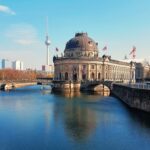Berlin, a city known for its vibrant culture and history, houses one of the world’s most impressive museums – the Pergamon Museum. Located on the Museum Island, this architectural marvel offers a fascinating glimpse into ancient civilizations. Whether you’re an art enthusiast, a history buff, or simply curious, the Pergamon Museum is a must-visit destination that promises a unique journey through time.
History of the Pergamon Museum
The Pergamon Museum, part of Berlin’s Museum Island, was constructed between 1910 and 1930. Named after the ancient city of Pergamon, the museum was designed to house and showcase monumental archaeological finds. It stands as a testament to early 20th-century architectural and museological innovation, reflecting a dedication to preserving and presenting ancient artifacts in a grand, accessible manner.
Architectural Marvel
The Pergamon Museum’s architecture itself is a sight to behold. Designed by Alfred Messel and completed by Ludwig Hoffmann, the museum is divided into three main sections: the Collection of Classical Antiquities, the Museum of the Ancient Near East, and the Museum of Islamic Art. Each section boasts a unique architectural style that enhances the presentation of the artifacts within.
The Great Altar of Pergamon
One of the most famous exhibits in the museum is the Great Altar of Pergamon. This monumental structure dates back to the 2nd century BC and is adorned with a frieze depicting the battle between the gods and the giants. The sheer size and detail of the altar leave visitors in awe, providing a profound connection to the ancient world.
The Ishtar Gate
The Ishtar Gate, another highlight of the Pergamon Museum, was originally built by King Nebuchadnezzar II around 575 BC in Babylon. This magnificent gate, reconstructed in the museum, showcases stunning glazed brickwork in vibrant blues and golds, depicting dragons and bulls. It serves as a breathtaking example of ancient Near Eastern art and architecture.
Islamic Art Collection
The Museum of Islamic Art within the Pergamon Museum offers a rich collection of artifacts spanning from the 8th to the 19th century. Visitors can explore intricate textiles, ceramics, and architectural pieces, each telling a story of the diverse and sophisticated Islamic civilizations. Highlights include the Mshatta Facade and the Aleppo Room, both exemplary in their artistic and cultural significance.
Ancient Near East Collection
The Museum of the Ancient Near East features artifacts from Mesopotamia, Syria, and Anatolia, covering a vast timeline from the 6th millennium BC to the 1st millennium AD. The collection includes impressive statues, reliefs, and cuneiform tablets, providing a comprehensive overview of the ancient Near Eastern cultures and their contributions to human history.
Educational Programs and Tours
The Pergamon Museum offers a range of educational programs and guided tours designed to enhance the visitor experience. These programs provide deeper insights into the historical context and significance of the artifacts, making the museum’s extensive collection more accessible and engaging for visitors of all ages.
Temporary Exhibitions
In addition to its permanent collections, the Pergamon Museum hosts temporary exhibitions that explore various themes and periods in history. These exhibitions often feature loans from other prestigious museums, offering visitors the opportunity to see rare and unique artifacts that complement the museum’s permanent displays.
Accessibility and Visitor Information
The Pergamon Museum is committed to providing an inclusive experience for all visitors. The museum is wheelchair accessible, and assistance is available for those with mobility challenges. Audio guides and informational brochures are available in multiple languages, ensuring that everyone can fully appreciate the museum’s offerings.
Planning Your Visit
When planning a visit to the Pergamon Museum, it’s advisable to purchase tickets in advance, especially during peak tourist seasons. The museum is easily accessible by public transportation, and nearby attractions on Museum Island make it a convenient and enriching stop on any Berlin itinerary.
Nearby Attractions
Museum Island itself is home to several other notable museums, including the Altes Museum, the Neues Museum, the Bode Museum, and the Alte Nationalgalerie. Each of these institutions offers unique collections and exhibits, making Museum Island a comprehensive cultural destination. Visitors can also enjoy the nearby Berliner Dom, a stunning cathedral offering panoramic views of the city.
Tips for a Memorable Visit
To make the most of your visit to the Pergamon Museum, consider these tips:
- Allocate ample time to explore each section of the museum thoroughly.
- Take advantage of the educational tours and audio guides for a more enriching experience.
- Visit during weekdays or early in the day to avoid the largest crowds.
- Pair your visit with other Museum Island attractions for a full day of cultural immersion.
Conclusion
The Pergamon Museum in Berlin is a treasure trove of ancient history and art. From the awe-inspiring Great Altar of Pergamon to the intricate artifacts of the Islamic and Near Eastern collections, the museum offers an unparalleled journey through the civilizations that shaped our world. Whether you’re a seasoned historian or a curious traveler, a visit to the Pergamon Museum is a captivating experience that will leave you with a deeper appreciation of our shared heritage.
FAQs
What are the opening hours of the Pergamon Museum?
The Pergamon Museum is typically open from 10 AM to 6 PM, with extended hours on Thursdays. It’s best to check the official website for any changes or special hours.
Is the Pergamon Museum suitable for children?
Yes, the museum offers various programs and activities designed for children, making it an educational and enjoyable experience for young visitors.
Are there guided tours available at the Pergamon Museum?
Yes, guided tours are available and highly recommended to gain deeper insights into the exhibits and their historical contexts.
Can I take photographs inside the Pergamon Museum?
Photography is generally allowed in most areas of the museum, but the use of flash and tripods is usually prohibited. It’s advisable to check specific exhibit rules.
Is there a café or restaurant at the Pergamon Museum?
The museum has a café where visitors can enjoy refreshments. There are also several dining options nearby on Museum Island.
How do I get to the Pergamon Museum by public transport?
The museum is easily accessible by public transport, including U-Bahn, S-Bahn, and tram services. The nearest stations are Friedrichstraße and Hackescher Markt.



